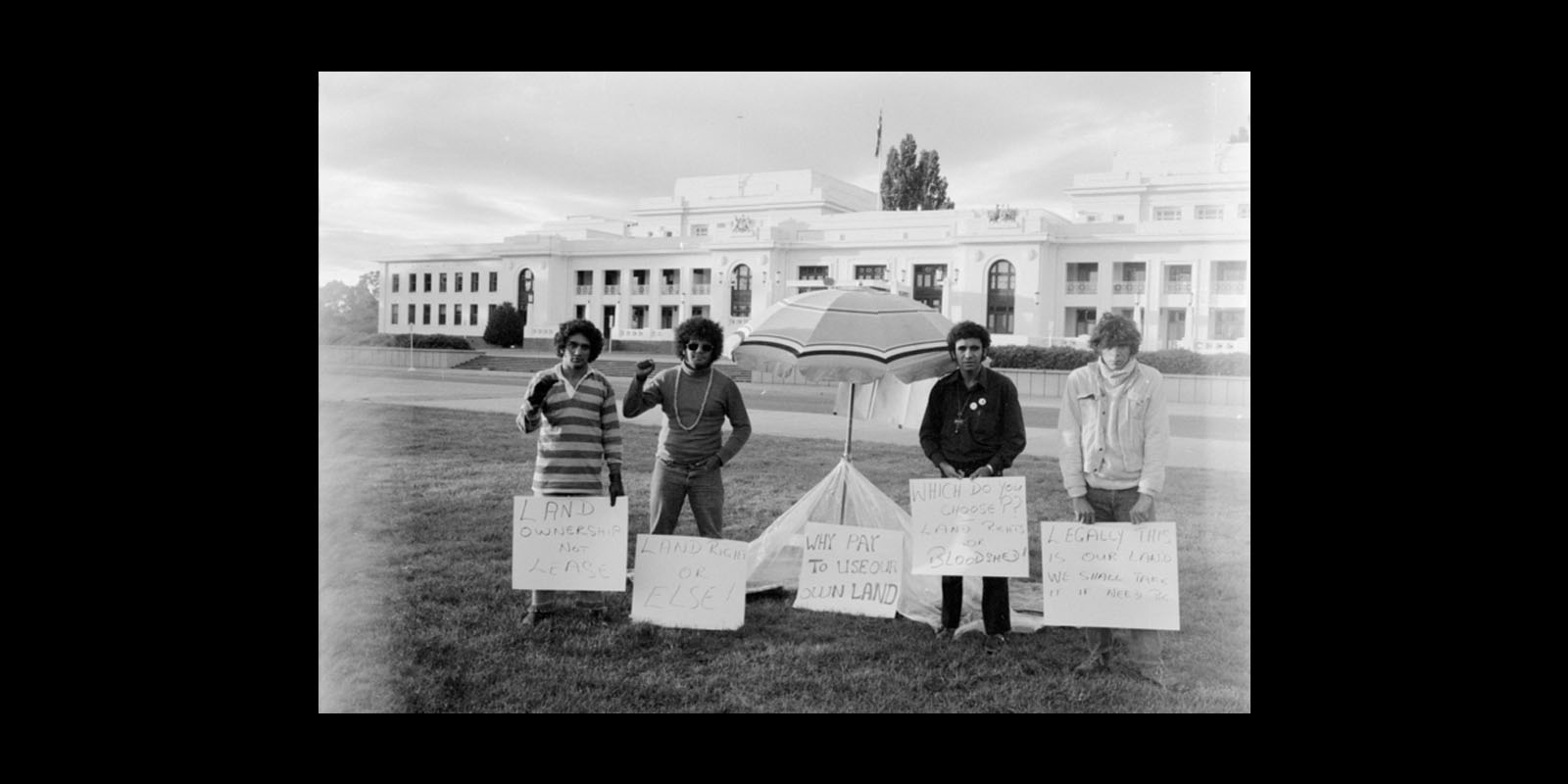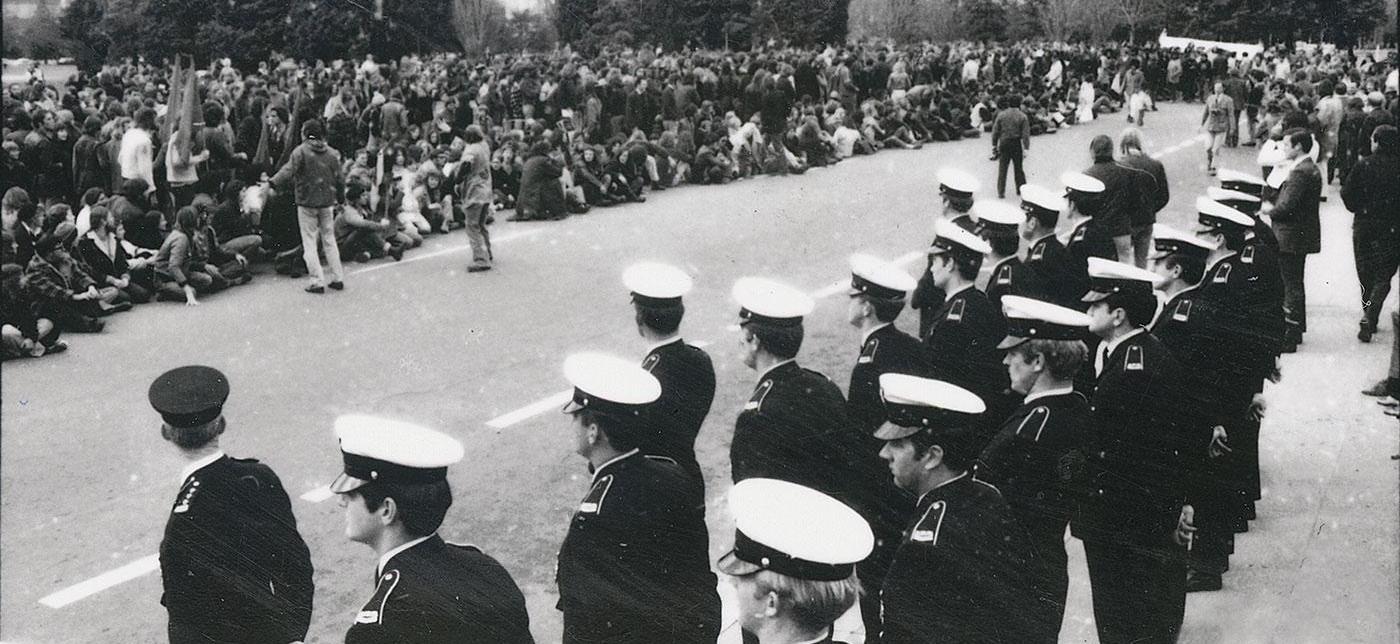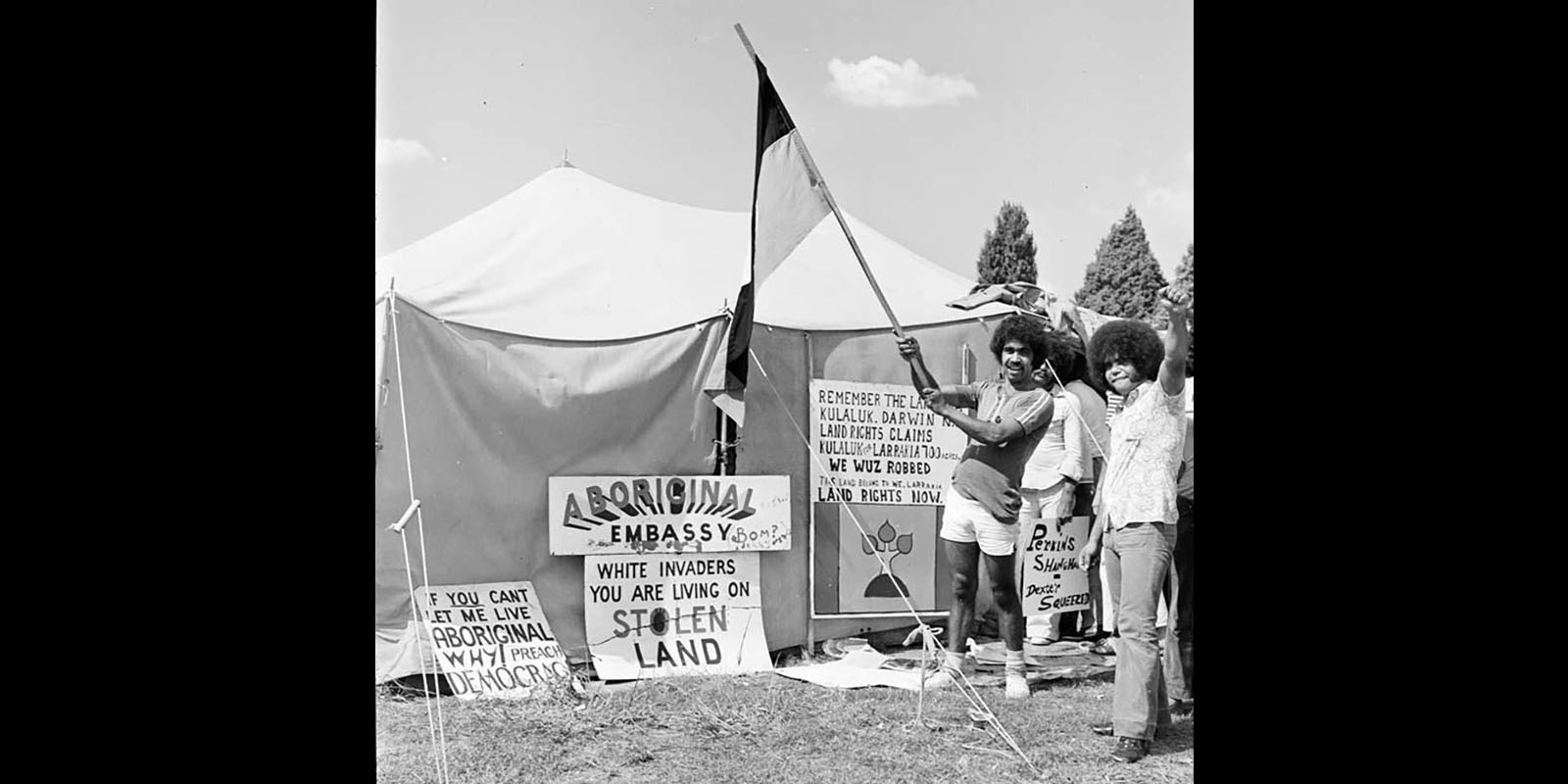The Aboriginal Tent Embassy was set up by Aboriginal activists on the lawns opposite Parliament House in 1972 to protest the Government’s refusal to acknowledge Aboriginal land rights.
It was originally a simple beach umbrella and tent that became a hub and meeting place for Aboriginal land rights and sovereignty activism. The Embassy took many forms over the years and continues to be a powerful symbol for Aboriginal rights to this day.
A land rights issue
In the lead up to the formation of the Tent Embassy, there were battles over Aboriginal land rights occurring all over the Country, with many different Mobs standing up to protect Country.
In 1968, the people of Yirrkala (Northern Territory) took up a legal case against the mining company Nabalco and the Commonwealth of Australia over the ownership of their land. In 1972, the Court ruled in favour of Nabalco concluding “the relationship between clan and land did not amount to proprietorship as that is understood in our law.” This was an injustice to the Yirrkala people and did not reflect the lore of their ancestors. They therefore sent representatives to Canberra to present a statement to then Prime Minister, William McMahon.
While this was taking place the Gurindji people were also fighting for rights to their traditional lands in Wattie Creek (Northern Territory) by going on strike.
Following these struggles, the Australian Government announced that they would not grant any ‘Aboriginal title’ to land – this means they would not recognise Aboriginal rights to land based on occupation and care for Country over thousands of generations. Aboriginal people in the Northern Territory were instead encouraged to apply for leases that would be approved if they showed that the land would be put to ‘reasonable’ social or economic use.


Image: First day of the Aboriginal Tent Embassy, outside Parliament House, Canberra, 27 January 1972. Left to right: Billy Craigie, Bert Williams, Michael Anderson and Tony Coorey. Image courtesy The Tribune / SEARCH Foundation.
The Tent Embassy is born
In January 1972, four young Aboriginal men, Billy Craigie, Tony Coorey, Michael Anderson and Bert Williams drove from Sydney to Canberra to protest the Government’s statement rejecting Aboriginal land rights.
The land was taken from us by force ... We shouldn't have to lease it ... Our spiritual beliefs are connected with the land – Michael Anderson
Late on Invasion Day, they placed a beach umbrella and a tent on the lawns outside Parliament House with a sign that read ‘Aboriginal Embassy.’ The protest was powerful and showed how Aboriginal people had been made to feel foreign to their own lands. It received a lot of media attention and support from both Aboriginal and non-Aboriginal people.
On the 6th of February, the Embassy issued a list of demands to the Government that focused on land rights issues. The demands were:
- Complete rights to the Northern Territory as a state within Australia and the installation of a primarily Aboriginal State Parliament. These rights would include all mining rights to the land.
- Ownership and mining rights of all other Aboriginal reserve lands in Australia.
- The preservation of all sacred sites in Australia.
- Ownership of areas in major cities, including the mining rights.
- Compensation for lands that were not able to be returned starting with $6 billion and including a percentage of the gross national income every year (Source: National Museum of Australia).
Following this, the then opposition leader Gough Whitlam met with the Embassy to discuss their demands. This was seen as a win by activists as they were having their ideas and arguments were being heard and recognised by people in power.
SBS's 'The Feed' explores the history of the Tent Embassy and how it has become a symbol for the fight for the rights of Aboriginal people.
Support
Within days many other Aboriginal and racial justice activists joined those at the embassy such as Gordon Briscoe, Paul Coe, Gary Foley, Bruce McGuinness and Roberta Sykes. By the time Parliament resumed in mid-February there were eleven tents sent up on the lawns in support of the Embassy. Both Aboriginal and non-Aboriginal people stood together in solidarity to protest the McMahon Government’s stance on land rights.
Aliens in our own land, so like other aliens, we needed an embassy – Gary Foley
In March, the Embassy leaders addressed Australian National University students, asking for their support. Students joined the crowd on the lawns and opened up a bank account through the Student Representative Council to support the Embassy.
The Tent Embassy also received wide international support receiving visits from members of the Canadian Indian Claims Commission, Soviet diplomats and an Irish Republican Army member.
While the Embassy was received wide-ranging support, a large portion of politicians and the general public believed they were trespassing and nothing more than an annoyance on the lawns of Parliament.


Image: View from Parliament House of police and protesters at a land rights demonstration, Canberra, 30 July 1972. National Museum Australia.
Removal and re-establishment
The Embassy was under a lot of pressure from authorities to move from the lawns of Parliament. On the July 20, police violently clashed with hundreds of protestors forcibly removing them from the lawns, with many protestors being arrested and many tents being torn down.
By the following week, protesters had re-erected the Embassy and tents, however another clash with authorities saw the tents torn down again. This time however, images of the police being violent with protestors spread across the media, raising awareness and support for the Embassy.
On 31 July 1972, more than 2000 people were present when the tents were re-erected by protesters in a peaceful demonstration.
Between 1972 and 1992, the Embassy was established at a number of locations across Canberra, including the site of the current Australian Parliament House (after it was built in 1981). They continued to focus on land rights but also on other issues facing Aboriginal people such as funding for Aboriginal communities, political representation, self-determination and sovereignty. It eventually became a permanent fixture outside of old Parliament House in 1992 and in 1995 the Embassy was listed on the Australian Heritage Commission’s National Estate.


Image: Activists at the Aboriginal Tent Embassy on the lawns of (Old) Parliament House in Canberra in 1974. National Archives of Australia.
In 2018
The Aboriginal Tent Embassy has been around for over 40 years now and still continues to be a hub and symbol for the fight for our rights and for the sovereignty of our people to be recognised. Many protests and marches begin and end there and it has become an icon for Mob across Australia.
The embassy represents the continuing struggle for land rights and determination to end discrimination - Isabell Coe
Visitors and Community members alike are encouraged to visit the Embassy to place gum leaves on the ceremonial fire as well as to sit and talk to those at the Embassy about its long history and the about all the Aboriginal political movements in its time.
Tent Embassy Documentary
A documentary by Francis Little about the establishment of the Tent Embassy. [Run time 55 mins].
Sources used in writing this article:
- Aboriginal Tent Embassy, Official Website.
- Aboriginal Tent Embassy, National Museum Australia
- Aboriginal Embassy, 1972, National Museum Australia
- The history of the Aboriginal Tent Embassy, ABC News
- Timeline: Aboriginal Tent Embassy, NITV.
